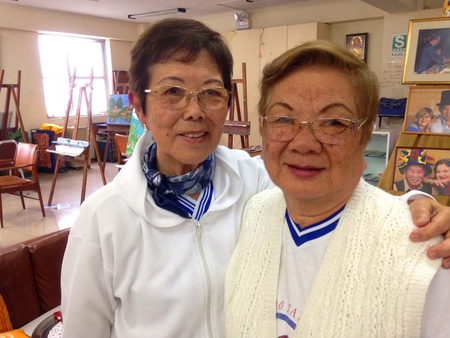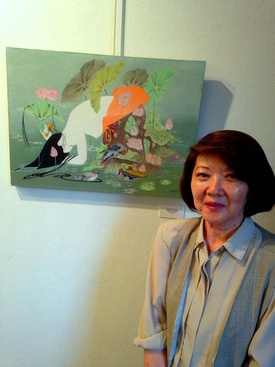Our memories are filled with sad and happy landscapes that speak to each other. I asked some Nikkei to share their childhood memories, Christmas holiday customs, and family traditions. Members of the “Road to Happiness” painting workshop, a program of the Ryoichi Jinnai Recreational Center for the Elderly which is part of the Japanese-Peruvian Association, spent some time in the days before Christmas to share their memories over coffee and sweetbread.
Naoko Yamauchi: “There is a lot of happiness in my life”
Naoko Yamauchi wears a shirt with the logo of Radio Taiso, the morning radio exercise program that is practiced by office workers in Japan before starting the workday. She is one of the newest students in the painting workshop, which is now part of her family, both large and far-flung, since three of her four siblings live outside Peru (two in the United States and one in Japan).
She never married, so she celebrates Christmas with her nieces and nephews and another Nikkei family who lives in her building. She says her parents passed down Japanese values (honor, duty, and punctuality) to her, although they had no Christmas customs of their own. They do have some for the New Year: pork dishes, kombu, and sushi were always present.
“There is a lot of happiness in my life,” says Naoko, who was a seamstress, worked two years in Japan, and participates in the workshop with a friend who is like a sister to her: Rosa Nakasone, a classmate from República de Brasil public school in Barrios Altos, and who also does the Radio Taiso exercises. “Our parents knew each other in Japan and we have been friends since school days, when we used to listen to soap operas on the radio.”

Rosa Nakasone: “My parents were always working”
Rosa Nakasone studied nursing and has worked at Rebagliati Hospital since it opened. Married, with three children and six grandchildren (although two of them live in Canada), she says that at Christmas they all gather together, celebrating by singing Christmas carols, praying, and worshiping Jesus. “My sister is the Mrs. Claus who brings presents,” she says.
These are happy and prosperous times, unlike what she experienced as a child. Rosa remembers that her father’s grocery store on Avenida Grau in downtown Lima was looted after Peru announced its support for the United States by declaring war on Japan. “Some neighbors took us in. We had to sleep and eat at the Lima Nikko school which closed down,” says Rosa, who was among the students in the 21st class that were unable to graduate due to the war.
“There was no family warmth. My parents were always working. There were no Sundays. I remember registering myself for school. Nor did they attend the meetings with teachers,” says Rosa, remarking also that since there was no money, at Christmas she and her two siblings received one pair of roller skates. “We took turns, each of us went around once,” she says.
Fernando Yogui: “Christmas should be a spiritual celebration”
Fernando Yogui Teruya studied language and literature but has been teaching and studying painting for several years. In his youth he played soccer, which enabled him to travel to different provinces of Peru. Today, as he approaches his 68th birthday which is on Christmas day, he has found in the workshop a space that is magical and familiar, “making us feel youthful, helping to transform our spirit at this age.”

He was born in the Rímac district, but soon afterwards his family moved to Magdalena, a neighborhood where he meet well-known Peruvian soccer players such as Ramón Mifflin, Roberto Chale, and Héctor Bailetti. “We played in the chapel, where there was a soccer field, in front of the square. We were there all night long until the guard kicked us out,” he says laughing.
Fernando had a happy childhood, even though his family had no money. “My father came from Japan having graduated from high school, which wasn’t common among the immigrants. He had been offered a good job but then it fell through.” “Our Christmas was Peruvian, very typical, with hot chocolate and sweetbread. Sometimes we had roasted pork,” says Fernando, who remembers that the first present he received was a rubber gun from his godfather. “My dad took it away from me immediately,” he says laughing. Now, as his wife is a very devout Catholic, he believes Christmas has become too commercial a celebration, when it should be spiritual. “It should be celebrated in a simple way,” he remarks.
He also said that Christmas and his birthday were on the same day. His family did not do anything extra for his birthday, so sometimes he thought that no one would remember that it was his special day too.
Graciela Nakachi: “In Japan New Year’s Eve is celebrated more than Christmas”

Masae Nakachi, or Doctor Graciela Nakachi, as she is known professionally, spent four years in Japan with her husband, Doctor Roberto Shimabuku, when he was studying for his doctoral degree. In Komagani, she fell in love with painting and continues to paint today in her free time. It was in Japan that she also experienced New Year’s parties in a different way.
“They don’t celebrate Christmas there, but they do celebrate New Year’s Eve. In the san-ga-nichi (the first three days of the year) all of the stores are closed, as everyone is visiting with relatives. Visitors are invited to obento, which is prepared the night before, so you don’t have to cook,” says Graciela, who celebrated Christmas by cooking for her husband.
“There are stores where you can buy everything in portions and it’s all ready," says the doctor, who taught Spanish in Japan. When she was a little girl, her father, Masao Nakachi, who started the painting workshop she participates in, usually prepared the Christmas dinner, a mixture of Peruvian and Japanese food. Her brother has since taken up the tradition. When she was on duty at the Children’s Hospital, the doctor learned some Peruvian New Year’s customs, such as eating 12 grapes or placing a glass of water to receive the first rays of light of the new year.
New Year’s in Japan
María Teresa Fukushima and Víctor Oshiro also shared some Christmas anecdotes. María Teresa, a poet who has had several professions (journalism, radio announcing, translation, etc.) and who lived in Japan for many years, remarks that one of the customs she remembers most is the visit to Buddhist temples to start the year by asking for good wishes. This is known as the hatsumōde.
“You spend the first day with family, and the days before with friends,” says María Teresa. That celebration, known as bonenkai, is when they say farewell to the year with colleagues, schoolmates, and friends. “But it’s not celebrated with as much fanfare as it is in Peru,” she adds. Victor was in Japan for four years, and the tradition he most remembers is eating soba noodles, a symbol of long life, on New Year’s Eve.
“You also see some Christmas trees, but not much more,” says Victor, comparing it to Peru, where Christmas is the most anticipated celebration with the most traditions, from the sweetbread shared by the workshop participants to presents, nativity figures, and a holiday meal. Typical decorations include Christmas lights. In Japan, for New Year’s the custom is to hang sacred ropes and provide an offering of mochi and bitter orange. “At home, our traditions are 50% Peruvian and 50% Japanese, but at Christmas we are more Peruvian.”
© 2015 Javier Garcia Wong-Kit





